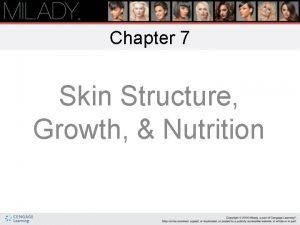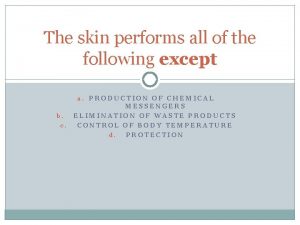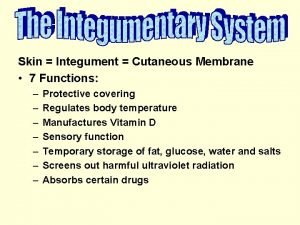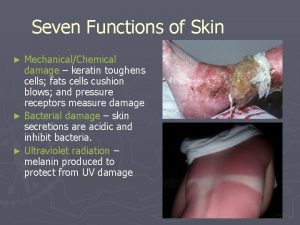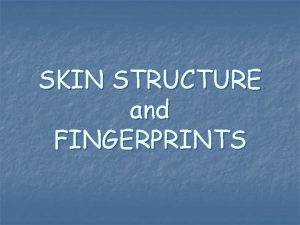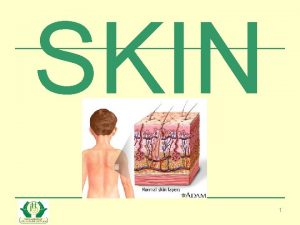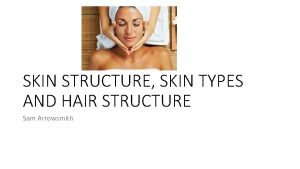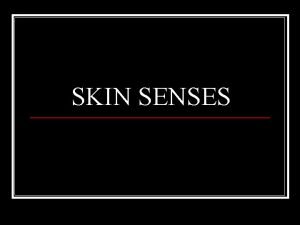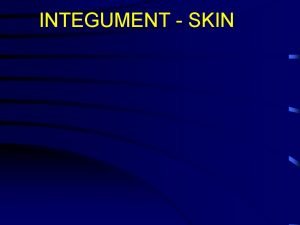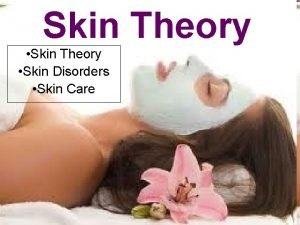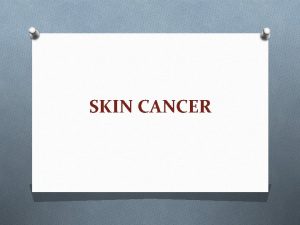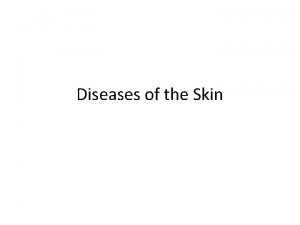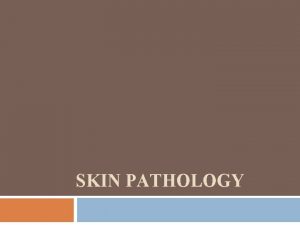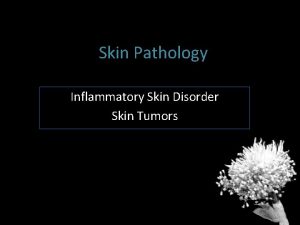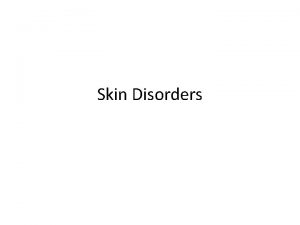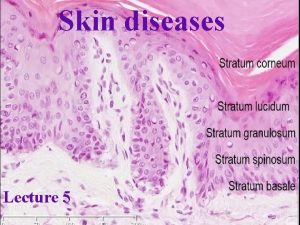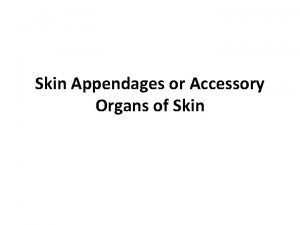Skin structure and functions Helen Green The skin























- Slides: 23

Skin structure and functions Helen Green

The skin structure • The skin is made of 3 layers: 1________ 2________ 3________

The skin structure The epidermis is made of 5 layers: 1__________ 2__________ 3__________ 4__________ 5__________ • Mitosis occurs in the basale layer. New cells are always pushed upwards. UV radiation increases skin growth and thickens the stratum corneum • Migration • Takes about 40 -56 days for a new cell to complete its migration to • the skin surface. It forms a scale and is removed by friction. • Nutrition • Blood capillary networks in the dermal papillae provide the food and oxygen for the skin growth

The Epidermis • This is the most superficial layer of the skin, composed of stratified epithelium (layered cells). The thinnest being on the _______ and the thickest on the ____ _______ and _____ ____. This layer is free from nerve endings of pain but is extremely sensitive to touch.

Pigment • The skins ______ produce two types of pigment; • Eumelanin: Black or brown • Phaemelanin: Yellowish-brown or red • The amount and distribution of these melanin pigments is responsible for the variation in the skin colour.

Stratum Germinativum- Basal Layer • This is the deepest layer of the epidermis and its lower surface is attached to the dermis, from which it receives nutrient fluid from the blood vessels. • Development of new cells; _______ occurs here. This leads to a gradual displacement of older cells towards the surface. • Melanin-forming cells called melanocytes are formed in this layer. Melanin is the skins natural protection against harmful effects of ______ and is responsible for the change in the skin colour when exposed to the sun

Stratum Spinosum • This consists of the cells immediately above the basal layer. • Each cell connects with the next by means of fine threads or filaments through which they receive nourishment from the tissue fluid or protoplasm. • Towards the upper part of the layer, chemical changes take place and the _____process has begun

Keratinistion Using the internet and text books, research the meaning of the word keratinisation ______________________________________ ___________________

Stratum Granulosum-Granular layer • The final stages of keratinisation takes place in this layer • The cells become flattened and the nucleus begins to disintegrate • There is a loss of fluids which contributes to the transformation of cells into keratin, a tough fibrous protein

Stratum Lucidum- transparent layer • This is made up of small, tightly packed transparent cells with no nucleus • This layer is thought to be the barrier zone controlling the transmission of water through the skin • It lies between the outer horny layer and the inner granular layer • It is more evident in the thickest areas of the skin, the soles of the feet and palms of the hands.

Stratum Corneum- horny layer • This consists of several layers of keratinised epithelial cells tightly packed together. • The superficial layers are constantly being shed and the cells beneath contain epidermal fatty substance resembling bees’ wax. • This keeps them _____ and helps prevent the skin from cracking and becoming open to bacterial infection.


Subcutaneous Layer • This layer is an area for the formation and storage of fat, a combination of: • Adipose tissue-containing fat cells • Areolar tissue- containing elastic fibres, which makes this layer elastic and flexible • It is thicker in women than men, thus giving a more rounded appearance to their contours. As fat is a poor conductor of heat, the hypodermis helps to reduce the loss of heat through the skin and also keep the body warm.

Functions of the Skin • • S- secretion H- heat regulation A- absorption P- protection E- excretion S- sensation V- vitamin D production

secretion

Heat Regulation

Absorption

Protection

Excretion

Sensation

Vitamin D production

Appendages to the Skin • The sebaceous glands • Are situated in the dermis opening into the hair follicle and are found all over the body • They are more numerous in the scalp and the face particularly around the forehead, nose, cheeks and chin • Although the glands secrete sebum- the skins own moisturiser, it can attract dirt, trapping it on to the skin and causing blackheads, papules and pustules. • The sebaceous glands are effected by the endocrine system and during puberty can become overactive • The male sex hormone testosterone causes the gland to enlarge. The female sex hormone oestrogen decreases the size of the gland

The Sudoriferous or Sweat glands • These glands consist of a coiled base emanating from the deeper layers of the dermis, a tube-like duct which rises through the epidermis ending at the skins surface to form a _____. • The eccrine glands- they are found all over the body, having a duct and a pore through which secretions are brought to the skin surface • The apocrine glands- they are connected with the hair follicles and are found chiefly in underarms, breast and genital areas of the body. As well as water and salt, fatty substances are secreted from these glands and react with the air to cause body odour
 Midtown computer solutions helen speaking
Midtown computer solutions helen speaking Teaj
Teaj Show me green
Show me green Skin information
Skin information Thin skin vs thick skin
Thin skin vs thick skin Describe the differences between alipidic and oily skin.
Describe the differences between alipidic and oily skin. Lernpyramide von green & green (2005)
Lernpyramide von green & green (2005) Red green yellow orange blue black white brown pink purple
Red green yellow orange blue black white brown pink purple Frc driver station mac
Frc driver station mac Skin structure growth and nutrition
Skin structure growth and nutrition The skin performs all of the following functions except
The skin performs all of the following functions except 7 functions of skin
7 functions of skin Seven functions of skin
Seven functions of skin Hình ảnh bộ gõ cơ thể búng tay
Hình ảnh bộ gõ cơ thể búng tay Bổ thể
Bổ thể Tỉ lệ cơ thể trẻ em
Tỉ lệ cơ thể trẻ em Chó sói
Chó sói Chụp phim tư thế worms-breton
Chụp phim tư thế worms-breton Chúa yêu trần thế alleluia
Chúa yêu trần thế alleluia Các môn thể thao bắt đầu bằng tiếng nhảy
Các môn thể thao bắt đầu bằng tiếng nhảy Thế nào là hệ số cao nhất
Thế nào là hệ số cao nhất Các châu lục và đại dương trên thế giới
Các châu lục và đại dương trên thế giới Công của trọng lực
Công của trọng lực









